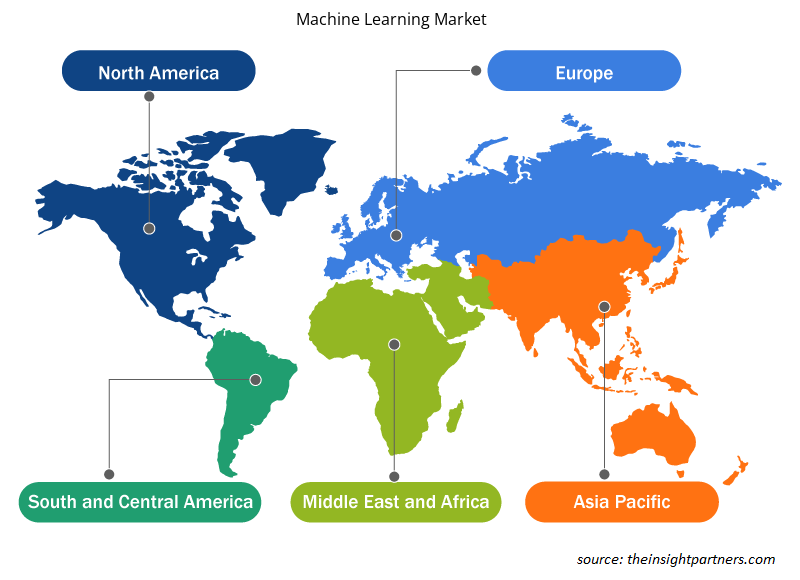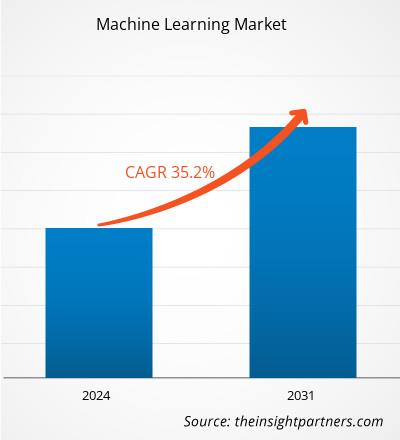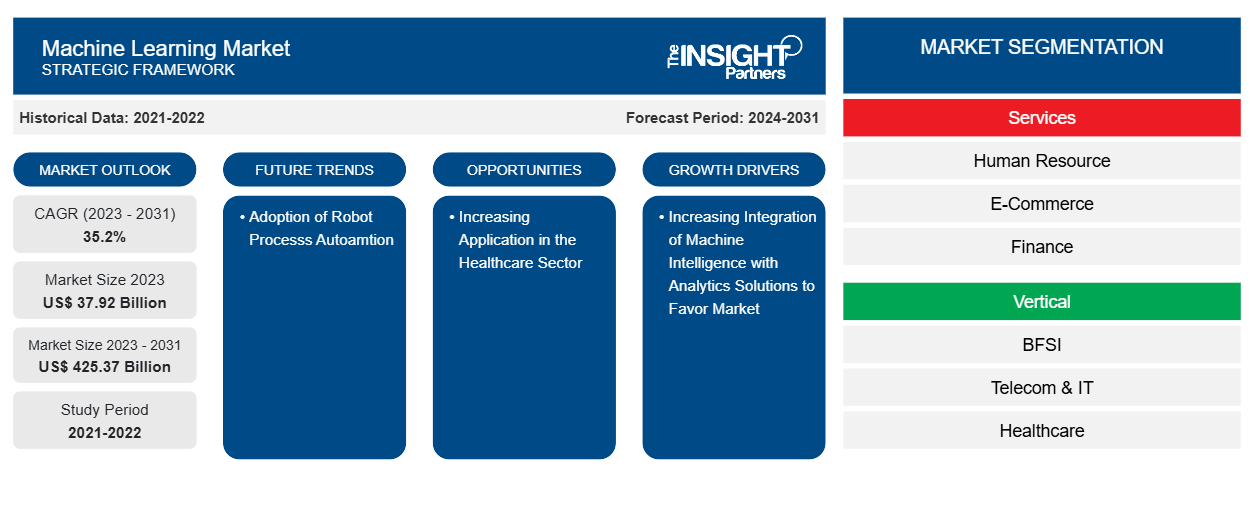Se proyecta que el tamaño del mercado de aprendizaje automático alcance los 425.370 millones de dólares en 2031, frente a los 37.920 millones de dólares en 2023. Se espera que el mercado registre una CAGR del 35,2 % entre 2023 y 2031. Es probable que la creciente integración de la inteligencia artificial y el aumento de las aplicaciones en el sector sanitario sigan siendo tendencias clave del mercado de aprendizaje automático.
Análisis del mercado del aprendizaje automático
El subcampo de la informática y la inteligencia artificial se conoce como aprendizaje automático. Para aumentar la precisión, se centra en los datos y los algoritmos. La tecnología que permite que una computadora aprenda de los datos históricos se denomina aprendizaje automático. Los algoritmos utilizados en el aprendizaje automático emplean una variedad de técnicas para extraer conocimiento de los datos históricos. La cantidad y los datos históricos están directamente relacionados con la información o la precisión de los datos, y esta relación ayuda al desarrollo de un modelo más preciso que pronostique datos futuros.
Descripción general del mercado del aprendizaje automático
Debido a sus avances tecnológicos, el aprendizaje automático es una tecnología emergente que se expande cada día. Se procesan grandes volúmenes de datos mediante el aprendizaje automático de acuerdo con las necesidades de la organización. Los humanos no pueden manejar la enorme cantidad de datos; por lo tanto, se necesitan sistemas informáticos para el análisis y la gestión de datos . El aprendizaje automático es una de esas herramientas. Se prevé que la necesidad de soluciones tecnológicas para gestionar datos y operaciones intrincados dentro de las empresas impulse el mercado del aprendizaje automático.
Personalice este informe según sus necesidades
Obtendrá personalización en cualquier informe, sin cargo, incluidas partes de este informe o análisis a nivel de país, paquete de datos de Excel, así como también grandes ofertas y descuentos para empresas emergentes y universidades.
-
Obtenga las principales tendencias clave del mercado de este informe.Esta muestra GRATUITA incluirá análisis de datos, desde tendencias del mercado hasta estimaciones y pronósticos.
Impulsores y oportunidades del mercado del aprendizaje automático
Aumentar la integración de la inteligencia de las máquinas con las soluciones analíticas para favorecer el mercado
La disciplina del análisis de ventas minoristas ha crecido significativamente en los últimos años. Mediante el uso de herramientas de análisis de datos de vanguardia, numerosas empresas de comercio electrónico, incluidas Alibaba, eBay y Amazon, han aumentado sus ingresos y mejorado la satisfacción del cliente. La investigación y el desarrollo en tecnología de reconocimiento de voz y de voz han llevado al surgimiento de técnicas de codificación cognitiva del habla basadas en ML.
Creciente aplicación en el sector sanitario para favorecer el mercado
Numerosas aplicaciones en el sector de la salud ya utilizan la tecnología ML. Esta plataforma evalúa millones de puntos de datos únicos en este sector industrial, pronostica resultados y ofrece una asignación precisa de recursos y puntuaciones de riesgo rápidas.
El diagnóstico y la identificación de enfermedades que pueden resultar difíciles de diagnosticar es uno de los usos más importantes de esta tecnología en el sector sanitario. Esto puede incluir varias enfermedades hereditarias y cánceres que son difíciles de identificar en las primeras etapas. IBM Watson Genomics es un ejemplo bien conocido de esto, que demuestra cómo la secuenciación de tumores basada en el genoma junto con la computación cognitiva puede ayudar en la detección del cáncer.
Análisis de segmentación del informe de mercado de aprendizaje automático
Los segmentos clave que contribuyeron a la derivación del análisis del mercado de aprendizaje automático son los servicios y los verticales.
- En función de los servicios, el mercado del aprendizaje automático se divide en recursos humanos, comercio electrónico, finanzas y contabilidad, atención al cliente, ventas y marketing, entre otros. Se prevé que el segmento de recursos humanos crezca en el período de pronóstico.
- Por sector vertical, el mercado está segmentado en BFSI, telecomunicaciones y TI, atención médica, automoción, fabricación, alimentos y bebidas, energía y electricidad, electrónica de consumo y otros. Se prevé que el segmento BFSI crezca en el período de pronóstico.
Análisis de la cuota de mercado del aprendizaje automático por geografía
El alcance geográfico del informe de mercado de Machine Learning se divide principalmente en cinco regiones: América del Norte, Asia Pacífico, Europa, Oriente Medio y África, y América del Sur/América del Sur y Central. América del Norte ha dominado el mercado de aprendizaje automático. Las tendencias de adopción de alta tecnología en varias industrias en la región de América del Norte han impulsado el crecimiento del mercado de aprendizaje automático. Se espera que factores como la mayor adopción de la digitalización y el alto gasto tecnológico por parte de las agencias gubernamentales impulsen el crecimiento del mercado de aprendizaje automático de América del Norte. Además, un fuerte énfasis en la investigación y el desarrollo en las economías desarrolladas de los EE. UU. Y Canadá está obligando a los actores norteamericanos a traer soluciones tecnológicamente avanzadas al mercado. Además, Estados Unidos tiene muchos actores del mercado de aprendizaje automático que se han centrado cada vez más en el desarrollo de soluciones innovadoras. Todos estos factores contribuyen al crecimiento de la región del mercado de aprendizaje automático.
Perspectivas regionales del mercado del aprendizaje automático
Los analistas de Insight Partners explicaron en detalle las tendencias y los factores regionales que influyen en el mercado del aprendizaje automático durante el período de pronóstico. Esta sección también analiza los segmentos y la geografía del mercado del aprendizaje automático en América del Norte, Europa, Asia Pacífico, Oriente Medio y África, y América del Sur y Central.

- Obtenga datos regionales específicos para el mercado de aprendizaje automático
Alcance del informe de mercado de aprendizaje automático
| Atributo del informe | Detalles |
|---|---|
| Tamaño del mercado en 2023 | US$ 37,92 mil millones |
| Tamaño del mercado en 2031 | US$ 425,37 mil millones |
| CAGR global (2023 - 2031) | 35,2% |
| Datos históricos | 2021-2022 |
| Período de pronóstico | 2024-2031 |
| Segmentos cubiertos |
Por Servicios
|
| Regiones y países cubiertos |
América del norte
|
| Líderes del mercado y perfiles de empresas clave |
|
Densidad de actores del mercado de aprendizaje automático: comprensión de su impacto en la dinámica empresarial
El mercado del aprendizaje automático está creciendo rápidamente, impulsado por la creciente demanda de los usuarios finales debido a factores como la evolución de las preferencias de los consumidores, los avances tecnológicos y una mayor conciencia de los beneficios del producto. A medida que aumenta la demanda, las empresas amplían sus ofertas, innovan para satisfacer las necesidades de los consumidores y aprovechan las tendencias emergentes, lo que impulsa aún más el crecimiento del mercado.
La densidad de actores del mercado se refiere a la distribución de las empresas o firmas que operan dentro de un mercado o industria en particular. Indica cuántos competidores (actores del mercado) están presentes en un espacio de mercado determinado en relación con su tamaño o valor total de mercado.
Las principales empresas que operan en el mercado del aprendizaje automático son:
- Servicios web de Amazon, Inc.
- FICO
- Desarrollo empresarial de Hewlett Packard LP
- IBM
- Microsoft
Descargo de responsabilidad : Las empresas enumeradas anteriormente no están clasificadas en ningún orden particular.

- Obtenga una descripción general de los principales actores clave del mercado de aprendizaje automático
Noticias y desarrollos recientes del mercado del aprendizaje automático
El mercado del aprendizaje automático se evalúa mediante la recopilación de datos cualitativos y cuantitativos a partir de investigaciones primarias y secundarias, que incluyen publicaciones corporativas importantes, datos de asociaciones y bases de datos. A continuación, se incluye una lista de los avances del mercado:
- En febrero de 2024, XTX Markets, una de las empresas líderes en comercio algorítmico, se complace en anunciar el lanzamiento de XTY Labs, una nueva división de aprendizaje automático que estará dirigida por el recién nombrado director de investigación, el Dr. Atlas Wang.
(Fuente: XTX Markets, comunicado de prensa, 2024)
- En abril de 2024, AdTheorent Holding Company, Inc., uno de los pioneros en aprendizaje automático que utiliza soluciones orientadas a la privacidad para ofrecer valor medible a los anunciantes programáticos, y Miles Partnership, una empresa de marketing estratégico centrada exclusivamente en viajes y turismo, anunciaron los resultados de la campaña publicitaria digital VISIT FLORIDA Sun Seekers.
(Fuente: AdTheorent Holding Company, Inc., comunicado de prensa, 2022)
Cobertura y resultados del informe de mercado de aprendizaje automático
El informe "Tamaño y pronóstico del mercado de aprendizaje automático (2021-2031)" proporciona un análisis detallado del mercado que cubre las siguientes áreas:
- Tamaño del mercado y pronóstico a nivel global, regional y nacional para todos los segmentos clave del mercado cubiertos bajo el alcance.
- Dinámica del mercado, como impulsores, restricciones y oportunidades clave
- Principales tendencias futuras
- Análisis detallado de las cinco fuerzas de Porter y PEST y FODA
- Análisis del mercado global y regional que cubre las tendencias clave del mercado, los principales actores, las regulaciones y los desarrollos recientes del mercado.
- Análisis del panorama de la industria y la competencia que cubre la concentración del mercado, el análisis de mapas de calor, los actores destacados y los desarrollos recientes.
- Perfiles detallados de empresas
- Análisis histórico (2 años), año base, pronóstico (7 años) con CAGR
- Análisis PEST y FODA
- Tamaño del mercado, valor/volumen: global, regional y nacional
- Industria y panorama competitivo
- Conjunto de datos de Excel
Informes recientes
Informes relacionados
Testimonios
Razón para comprar
- Toma de decisiones informada
- Comprensión de la dinámica del mercado
- Análisis competitivo
- Información sobre clientes
- Pronósticos del mercado
- Mitigación de riesgos
- Planificación estratégica
- Justificación de la inversión
- Identificación de mercados emergentes
- Mejora de las estrategias de marketing
- Impulso de la eficiencia operativa
- Alineación con las tendencias regulatorias























 Obtenga una muestra gratuita para - Mercado de aprendizaje automático
Obtenga una muestra gratuita para - Mercado de aprendizaje automático